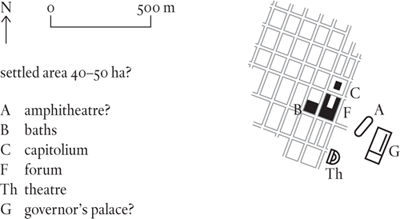
Zollfeld, Carinthia, Austria
Capital of the Roman province of Noricum, and, after its division, of its southern half, the Roman province of Noricum Mediterraneum; diocese: Illyricum
Noricum – the equivalent, roughly speaking, of modern Austria – was a Celtic kingdom of some dignity when it was annexed by Augustus in 15 BC. It had a history going back for 100 years or more, and a sort of capital in the oppidum of Noreia, twenty kilometres (12.4 miles) to the north of the present-day city of Klagenfurt. Like all Celtic oppida, Noreia was large – being spread over some three square kilometres (1.8 square miles) – but unfocused, and the scattering of buildings it contained didn’t add up to anything that Romans would have called a city. It was also inconvenient, being perched on top of the Magdalensberg. The situation was remedied by the emperor Claudius, who, sometime around AD 48, decided the time had come to give Noricum a proper capital. He chose a greenfield site some ten kilometres away in the Glan valley, had a street grid laid out and began building. The new town was called Virunum; it was to serve as the administrative centre for both the province and the local tribe, the Norici.
Virunum had the public buildings usual for a Roman town – a forum and adjacent capitolium (a public temple honouring higher deities), a set of baths, a theatre, and an oddly shaped amphitheatre that may have doubled as a racetrack. On the east side of town was a palatial villa, which some have seen as the residence of the procurator (governor) of Noricum. The town was never walled, which makes it difficult to judge how big it was. The street grid covered a large area, maybe as much as 100 hectares, but Roman surveyors often laid out more grid than was needed, and probably did so here. The evidence currently available suggests that the settled area was in the forty- to fifty-hectare range.
Virunum had a long and, so far as we can tell, generally uneventful history. Surprisingly, in view of its lack of defences, it emerged unscathed from the Marcomannic Wars (AD 169–75), which did great damage to many other communities in the Upper Danube area. It was not so lucky during the more serious incursions of the later third century, when the fact that the baths were burned down suggests at least one unhappy experience. This was probably of less importance to the standing of the town than the administrative demotion that occurred at the end of the third century when Diocletian recast the provincial structure of the empire. As was the case with many other provinces, Noricum was split in two, into Noricum Ripense (the northern half, bordering the Danube) and Noricum Mediterraneum (‘Inland Noricum’). Virunum retained its capital role in Noricum Mediterraneum, but Noricum Ripense was given a capital of its own in the shape of the Roman colony of OVILAVA.

The convulsions of the first half of the fifth century finished off Virunum. What was left of its bureaucracy retreated to the hill fort of Teurina, seventy kilometres (43.5 miles) to the west, which, under the title of Metropolis Norici, maintained a semblance of authority over the region during the pitiful last decades of the Western Empire.
The historian Géza Alföldy dismisses claims that Virunum’s population was ‘at most 50,000’, suggesting instead ‘at most 5–10,000’. This would apply only to the town’s best years, which were probably limited to the second and first half of the third centuries AD.